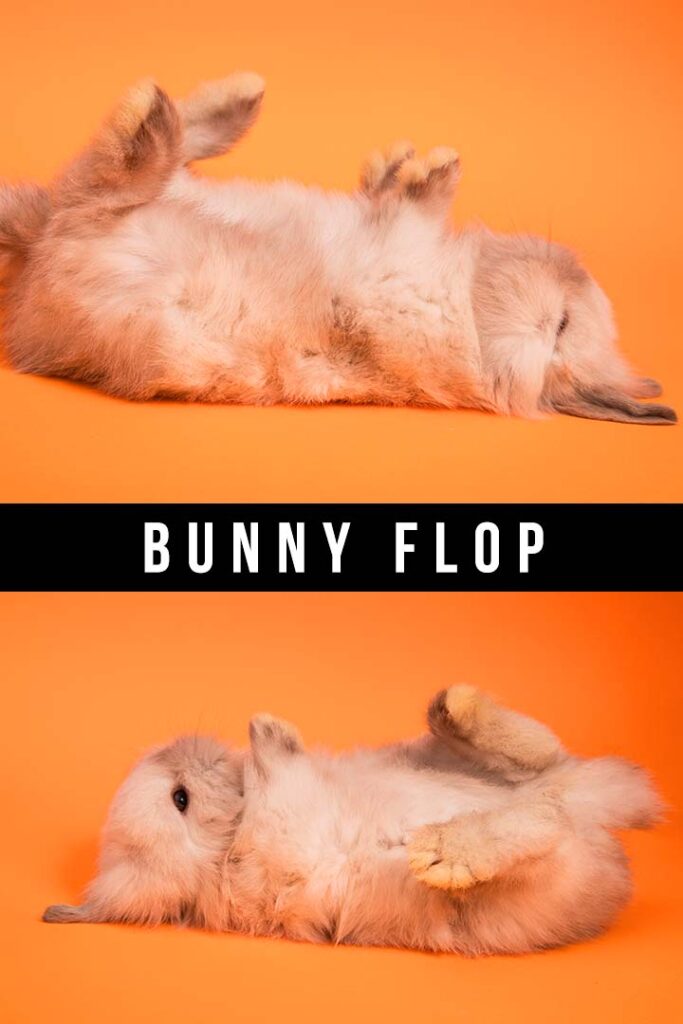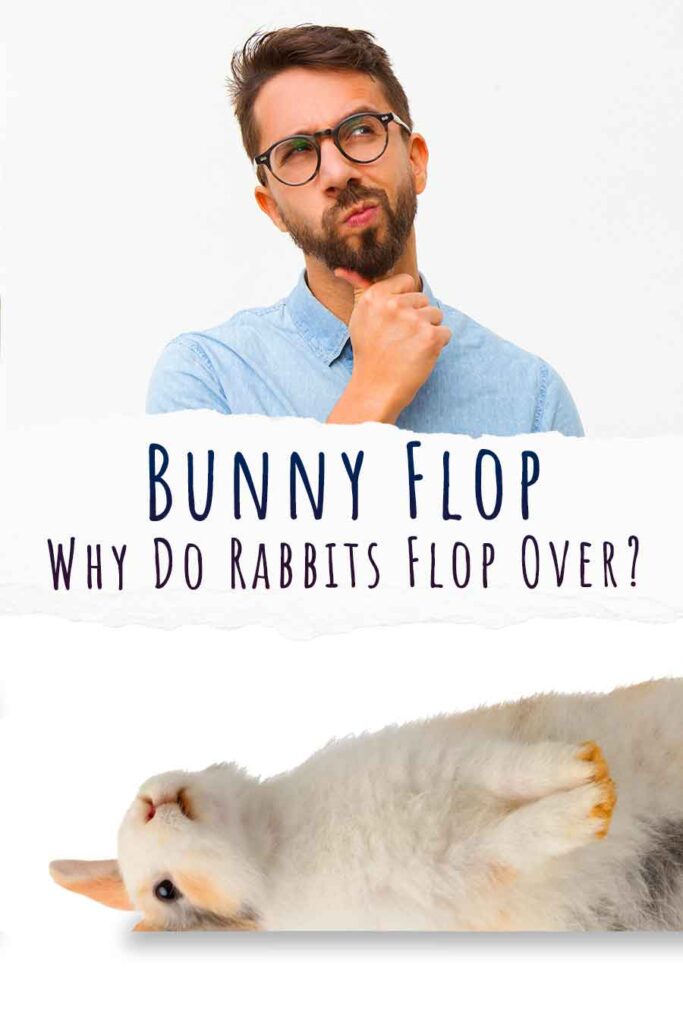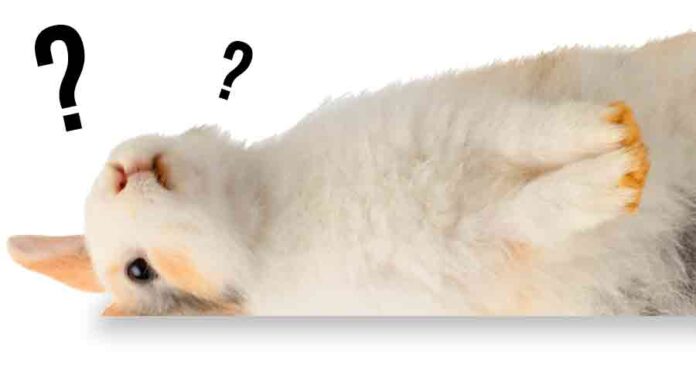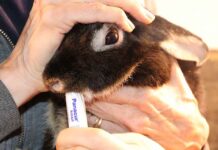This article unravels the mysteries of the bunny flop – including why they do it, what it means about you, and what you should do about it.
- What is a bunny flop?
- Why do bunnies flop?
- Why do bunnies flop on their side?
- How to encourage bunny floping
- Do bunnies ever flop in pain?
- What does it mean when a bunny flops – possibilities checklist
A bunny flop is when your rabbit dramatically collapses onto their side. It’s humorously known as the bunny death flop among rabbit owners, but it’s actually a sign that your bunny feels relaxed, safe and content.
In this sweet and funny video you can see bunny Pumpkin flopping as a young bachelor, and then flopping in a bonded pair with his buddy Snowdrop. Pumpkin clearly relishes an opportunity to flop over with all he’s got. Let’s find out more about what he’s thinking, why those flops are so dramatic, and how you can encourage your bunny to feel the same contentment.
What is a bunny flop?
A bunny flop is when a rabbit very suddenly adopts a lying down position on their side. And by suddenly, we mean SUDDENLY! Sometimes the action is so abrupt, owners even jokingly refer to it as the bunny death flop! A bunny flop often follows a period of activity, such as lively binkying, exploring, digging, foraging, or social grooming with a companion. Then all of a sudden, they fling themselves onto their side, paws stretched out, ears back, whole body relaxed, and eyelids heavy. Once down, a flopped bunny seems to visibly melt into position, and usually stays in their resting position for a little while.
Why do bunnies flop?
Like lots of animals, rabbits have evolved ways of communicating with each other and expressing how they’re feeling. Since they are a prey species, rabbits have developed a range of ways to communicate and express themselves using mainly body language and scent. They also use a small range of subtle noises, but not many, since making sounds can reveal their location to predators. When it comes to body language, rabbits tend to use whole body gestures or postures to send a message. And one of these is the famous bunny flop.
Bunnies flop as an expression of how they’re feeling, rather than to communicate information. And the feeling they’re expressing is rather lovely. A bunny flop is how rabbits show the world that they are feeling completely safe, relaxed, and content.
Why do bunnies flop on their side?
A bunny flop is usually followed by a period of resting. So it’s likely that rabbits flop sideways because it’s a comfortable position to end up in. You might also notice your rabbit always flops onto the same side, or likes to position himself so that he flops against a vertical surface for extra support and comfort. Sometimes, enthusiasm and momentum might carry a flopped bunny right onto their back!

Whilst rabbits choose flopping onto their side for comfort, the fact that they feel able to do so reveals something important about what they’re thinking and feeling. A flopped bunny has a restricted field of view, and their belly on display, which makes them vulnerable. A flop is also one of the slowest positions to get out of. So, they only do it when they feel absolutely safe, and confident that there is nothing dangerous nearby.
Why is a rabbit flop so sudden?
There’s one thing we don’t know about bunny flopping though, and that’s why it’s so dramatic! As you can see in the video at the top of this page, bunny flops are comical in their over the top-ness, and it’s impossible not to laugh at them. In fact they’re so startling that rabbit owners often refer to them as a death flop! But, we don’t really know why the movement is so sudden. It could be that such an exaggerated movement acts like a physical release for their inner feelings of intense satisfaction. Or it might be something else!
How to encourage bunny flopping
Since bunny flops come from such a happy place, there’s nothing you need to do about them. Every owner should love to see their bunny feeling happy and secure enough to flop around at home with them. Since flopping is an expression of feeling completely safe from danger, your rabbit is more likely to flop if you demonstrate that there are no threats to them in your home. Here are some tips for achieving that:
- Socialize your bunny to lots of experiences at a young age. Baby animals are much more trusting, and more inclined to form positive associations with things. Make the most of that by introducing them to as many people, sounds, and smells as possible, and making those encounters rewarding with tasty treats.
- With older rabbits, build up gradually. If you’ve adopted an older rabbit, allow them plenty of time to get used to you, and leave them lots of tasty treats without expecting anything in return.
- Don’t loom over them. As a prey species, rabbits are instinctively frightened by things which swoop down from above. Always try to approach them at eye level.
- Make sure they have lots of hiding places. A bunny with nowhere to retreat to if they sense a threat materializing is a stressed bunny.
- Make sure absolutely nothing can make them feel threatened. This means no unexpected noises or smells, and nothing unpredictable happening.
- Provide enrichments, such as opportunities to gnaw, dig and forage for food. Bunnies often flop right after doing something fun, but really it’s just the icing on the cake – everything else above needs to be in place too.
Do bunnies ever flop in pain?
And, if a rabbit will collapse dramatically to one side when they’re happy, how on Earth are you supposed to tell when they’re in pain?
These are both good questions! A rabbit in pain will sometimes collapse onto their side. The big difference is that rabbits instinctively hide pain for as long as possible, to avoid revealing themselves as easy targets for predators. So by the time they reach the point of collapse, a bunny has probably been struggling for a while. This means a bunny doing a happy flop can get up again quickly, but a bunny collapsed in pain is likely to have severe difficulty moving. Other signs they’re in pain include:
- twitching
- shivering
- weakness
- frothing or foaming at the mouth
- and irregular breathing, shallow breathing, or heaving breaths.
Since collapsing is usually a sign that an established health problem is finally getting too much for them, it’s obviously better to spot the problem sooner. Which is why it’s important to check these barometers of your rabbit’s health everyday:
- Appetite. Have they eaten and drunk normally today?
- Butt. Is the fur around their butt clean?
- Fur and skin. Is it clean, healthy looking, without bald patches or flakiness?
- Face. Are their eyes, ears and nose clean and free from discharge?
- Behavior. Are they acting normally?
- Body weight. Has their weight changed since last week? Can you feel their ribs, hips and spine easily, but not sharply?
- Teeth/gums. Rabbits rely on grazing to wear down their teeth – check they are not getting overly long.
- Feces. Rabbit pellets should be dry, crumbly, and pretty odorless. Soft smelly feces are a sign of diarrhea.
Once you’re used to making these checks, they only take a few moments each day, and you can incorporate them into your grooming, playing, or bonding routine. And it’s worth it – catching health problems early makes a big difference to the outcome for your bunny.

What does it mean when a bunny flops – possibilities checklist
Bunny flops are how rabbits express that they are feeling, happy and content. For any kind of happy flop to happen, they also need to feel safe, and certain that nothing threatening will materialise while they’re down. Some kinds of flops to look out for are:
- Flopping after binkying. Happy, safe and exhausted.
- Flopping after social grooming. Happy, safe and satisfied with a job well done and an emotional bond reinforced.
- Flopping after foraging or eating. Happy, safe and full up!
If your bunny flops over and can’t get up again easily, this is a sign that they actually need urgent veterinary attention.
Does your bunny love to flop?
Tell us about their funniest flops in the comments section down below! And don’t miss these articles about bunny behavior before you go:
- Why Do Rabbits Keep Turning Their Ears?
- Why do Rabbits Grunt?
- Rabbit Honking
- Why Do Rabbits Nudge Things?
- Are Rabbits Smart?
- Shy Bunny – How To Get A Timid Rabbit To Trust You
References
Dalley et al. Rabbit health practices of 202 rabbit owners. The Veterinary Nurse. 2018.
Leach et al. Are We Looking in the Wrong Place? Implications for Behavioural-Based Pain Assessment in Rabbits and Beyond? PLOS One. 2011.
Magnus. Behaviour of the pet rabbit: what is normal and why do problems develop? In Practice. 2005.
Shaw et al. Assessing pain in rabbits: how well does the Rabbit Grimace Scale work in the veterinary practice? The Veterinary Nurse. 2020.















Hellooowww! May I say how wonderful your article is, and what you write is EXACTLY what has happened here, with our bunny, called Merlin who I often call ‘Punkin’ and looks exactly like Pumpkin, your darling! Honestly they are peaz in a pod, with Merlin doing exactly what Pumpkin does, all day long, and I first time I saw him do it, not long after adopting him and he was outside in the garden I found him on side side after a bunny flop and I truly screamed coz I thought he was dead! So thank you so much for this most informative, magical, post. I so wish we could get Pumpkin and Merlin together, I swear they are kindred spirits – just different Mothers ! We certainly do not need to encourage the ‘bunny flop’! Thank you again …for such a wonderful article, and Pumpkin is wonder-full!